Investigating the Job Demands-Resources Model and Occupational Health
VerifiedAdded on 2023/04/21
|17
|4662
|324
Report
AI Summary
This report explores the relationship between job demands, job resources, burnout, and work engagement in the context of occupational health. It begins by defining job demands and resources, including cognitive, quantitative, emotional, and physical aspects, as well as spiritual resources. The report discusses job burnout as a result of prolonged stress and the importance of work engagement for organizational commitment and employee well-being. It examines the interplay between job demands and burnout, job resources and work engagement, and presents the Job Demand-Resource (JD-R) model, highlighting its motivational and energetic processes. The analysis covers the direct and indirect effects of job demands, the mediating role of burnout, and the impact of multiple job demands, ultimately emphasizing the importance of managing job demands and providing adequate resources to promote employee health and organizational success. Desklib provides a wealth of similar solved assignments and study resources for students.
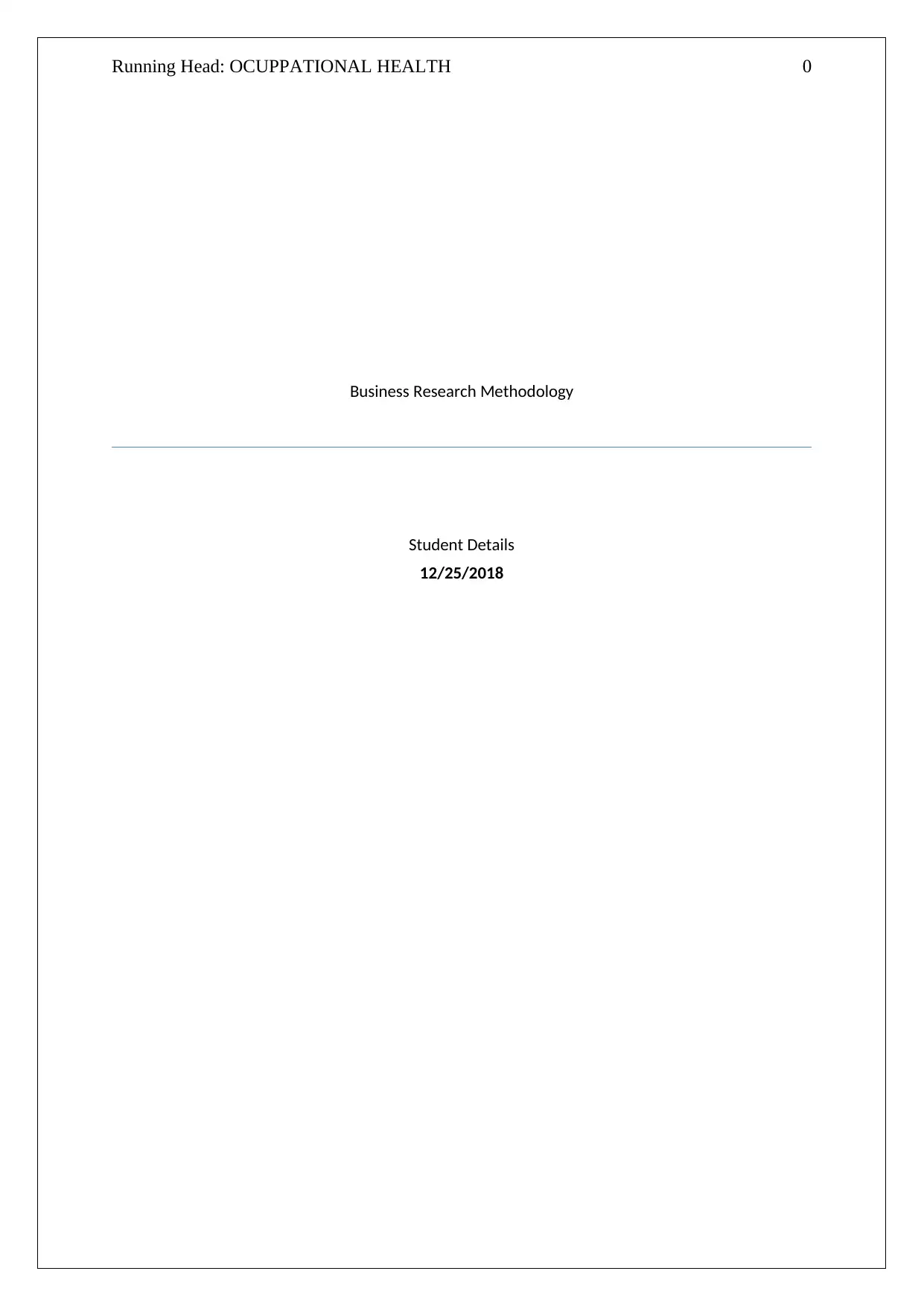
Running Head: OCUPPATIONAL HEALTH 0
Business Research Methodology
Student Details
12/25/2018
Business Research Methodology
Student Details
12/25/2018
Paraphrase This Document
Need a fresh take? Get an instant paraphrase of this document with our AI Paraphraser
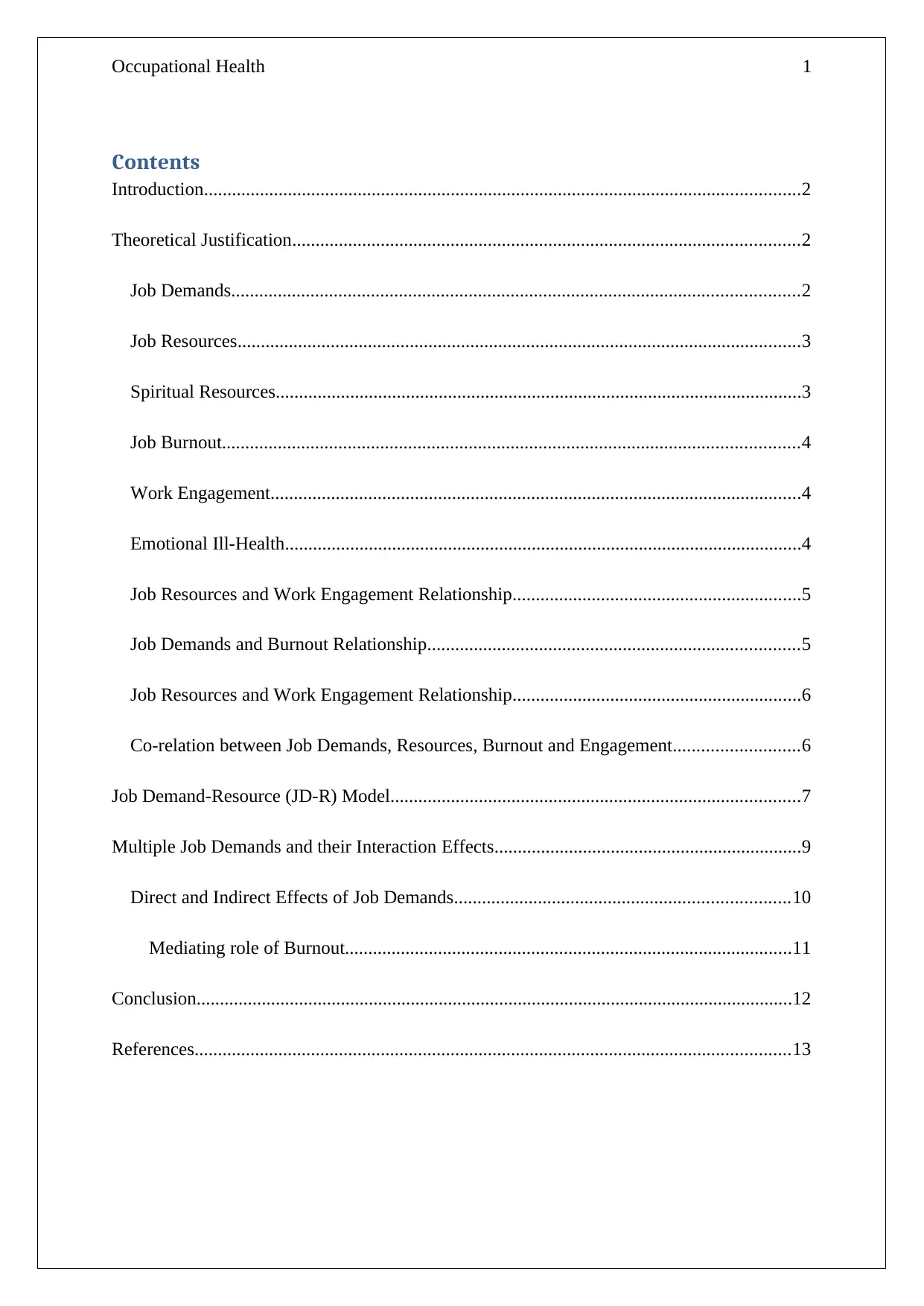
Occupational Health 1
Contents
Introduction................................................................................................................................2
Theoretical Justification.............................................................................................................2
Job Demands..........................................................................................................................2
Job Resources.........................................................................................................................3
Spiritual Resources.................................................................................................................3
Job Burnout............................................................................................................................4
Work Engagement..................................................................................................................4
Emotional Ill-Health...............................................................................................................4
Job Resources and Work Engagement Relationship..............................................................5
Job Demands and Burnout Relationship................................................................................5
Job Resources and Work Engagement Relationship..............................................................6
Co-relation between Job Demands, Resources, Burnout and Engagement...........................6
Job Demand-Resource (JD-R) Model........................................................................................7
Multiple Job Demands and their Interaction Effects..................................................................9
Direct and Indirect Effects of Job Demands........................................................................10
Mediating role of Burnout................................................................................................11
Conclusion................................................................................................................................12
References................................................................................................................................13
Contents
Introduction................................................................................................................................2
Theoretical Justification.............................................................................................................2
Job Demands..........................................................................................................................2
Job Resources.........................................................................................................................3
Spiritual Resources.................................................................................................................3
Job Burnout............................................................................................................................4
Work Engagement..................................................................................................................4
Emotional Ill-Health...............................................................................................................4
Job Resources and Work Engagement Relationship..............................................................5
Job Demands and Burnout Relationship................................................................................5
Job Resources and Work Engagement Relationship..............................................................6
Co-relation between Job Demands, Resources, Burnout and Engagement...........................6
Job Demand-Resource (JD-R) Model........................................................................................7
Multiple Job Demands and their Interaction Effects..................................................................9
Direct and Indirect Effects of Job Demands........................................................................10
Mediating role of Burnout................................................................................................11
Conclusion................................................................................................................................12
References................................................................................................................................13
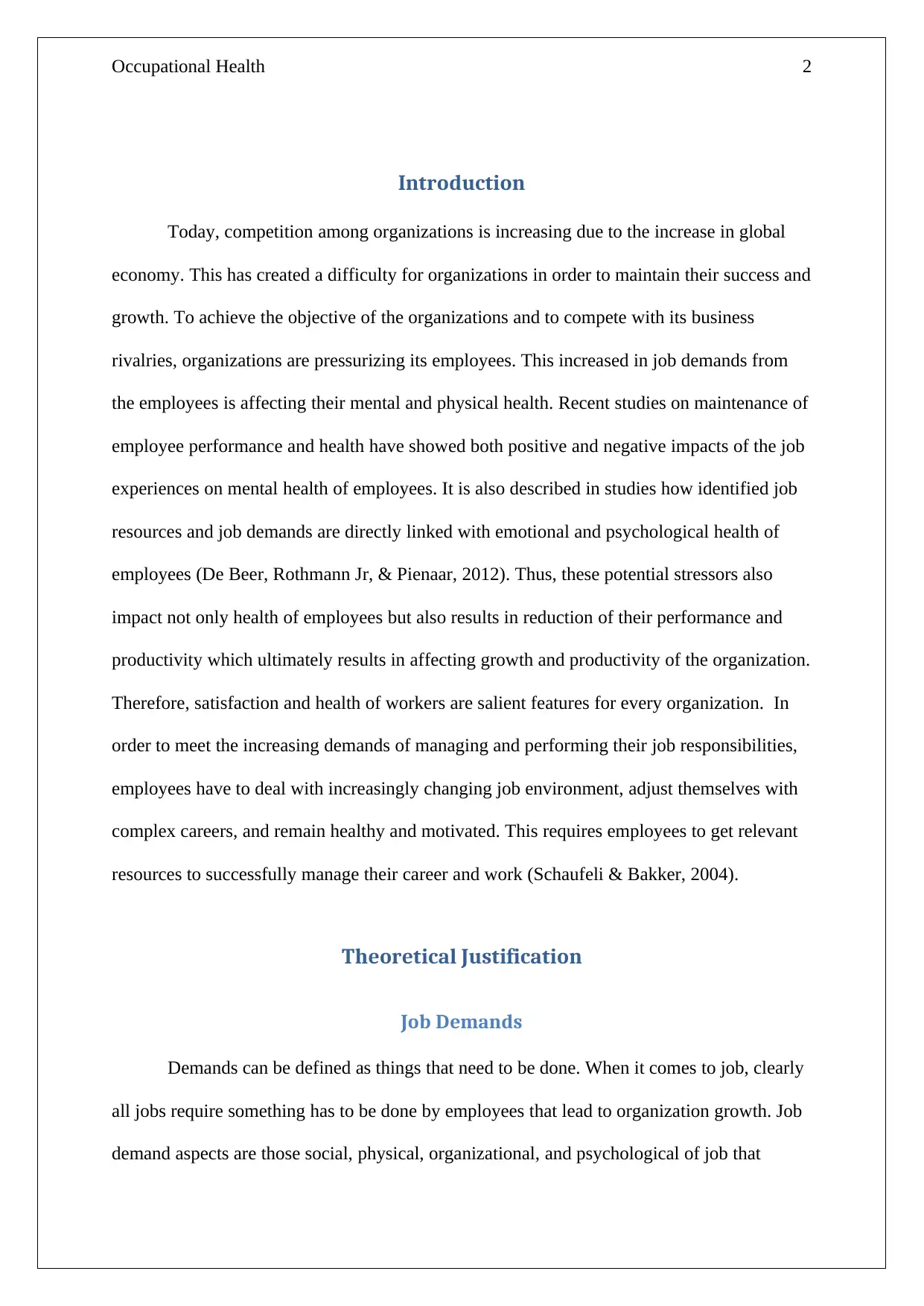
Occupational Health 2
Introduction
Today, competition among organizations is increasing due to the increase in global
economy. This has created a difficulty for organizations in order to maintain their success and
growth. To achieve the objective of the organizations and to compete with its business
rivalries, organizations are pressurizing its employees. This increased in job demands from
the employees is affecting their mental and physical health. Recent studies on maintenance of
employee performance and health have showed both positive and negative impacts of the job
experiences on mental health of employees. It is also described in studies how identified job
resources and job demands are directly linked with emotional and psychological health of
employees (De Beer, Rothmann Jr, & Pienaar, 2012). Thus, these potential stressors also
impact not only health of employees but also results in reduction of their performance and
productivity which ultimately results in affecting growth and productivity of the organization.
Therefore, satisfaction and health of workers are salient features for every organization. In
order to meet the increasing demands of managing and performing their job responsibilities,
employees have to deal with increasingly changing job environment, adjust themselves with
complex careers, and remain healthy and motivated. This requires employees to get relevant
resources to successfully manage their career and work (Schaufeli & Bakker, 2004).
Theoretical Justification
Job Demands
Demands can be defined as things that need to be done. When it comes to job, clearly
all jobs require something has to be done by employees that lead to organization growth. Job
demand aspects are those social, physical, organizational, and psychological of job that
Introduction
Today, competition among organizations is increasing due to the increase in global
economy. This has created a difficulty for organizations in order to maintain their success and
growth. To achieve the objective of the organizations and to compete with its business
rivalries, organizations are pressurizing its employees. This increased in job demands from
the employees is affecting their mental and physical health. Recent studies on maintenance of
employee performance and health have showed both positive and negative impacts of the job
experiences on mental health of employees. It is also described in studies how identified job
resources and job demands are directly linked with emotional and psychological health of
employees (De Beer, Rothmann Jr, & Pienaar, 2012). Thus, these potential stressors also
impact not only health of employees but also results in reduction of their performance and
productivity which ultimately results in affecting growth and productivity of the organization.
Therefore, satisfaction and health of workers are salient features for every organization. In
order to meet the increasing demands of managing and performing their job responsibilities,
employees have to deal with increasingly changing job environment, adjust themselves with
complex careers, and remain healthy and motivated. This requires employees to get relevant
resources to successfully manage their career and work (Schaufeli & Bakker, 2004).
Theoretical Justification
Job Demands
Demands can be defined as things that need to be done. When it comes to job, clearly
all jobs require something has to be done by employees that lead to organization growth. Job
demand aspects are those social, physical, organizational, and psychological of job that
⊘ This is a preview!⊘
Do you want full access?
Subscribe today to unlock all pages.

Trusted by 1+ million students worldwide
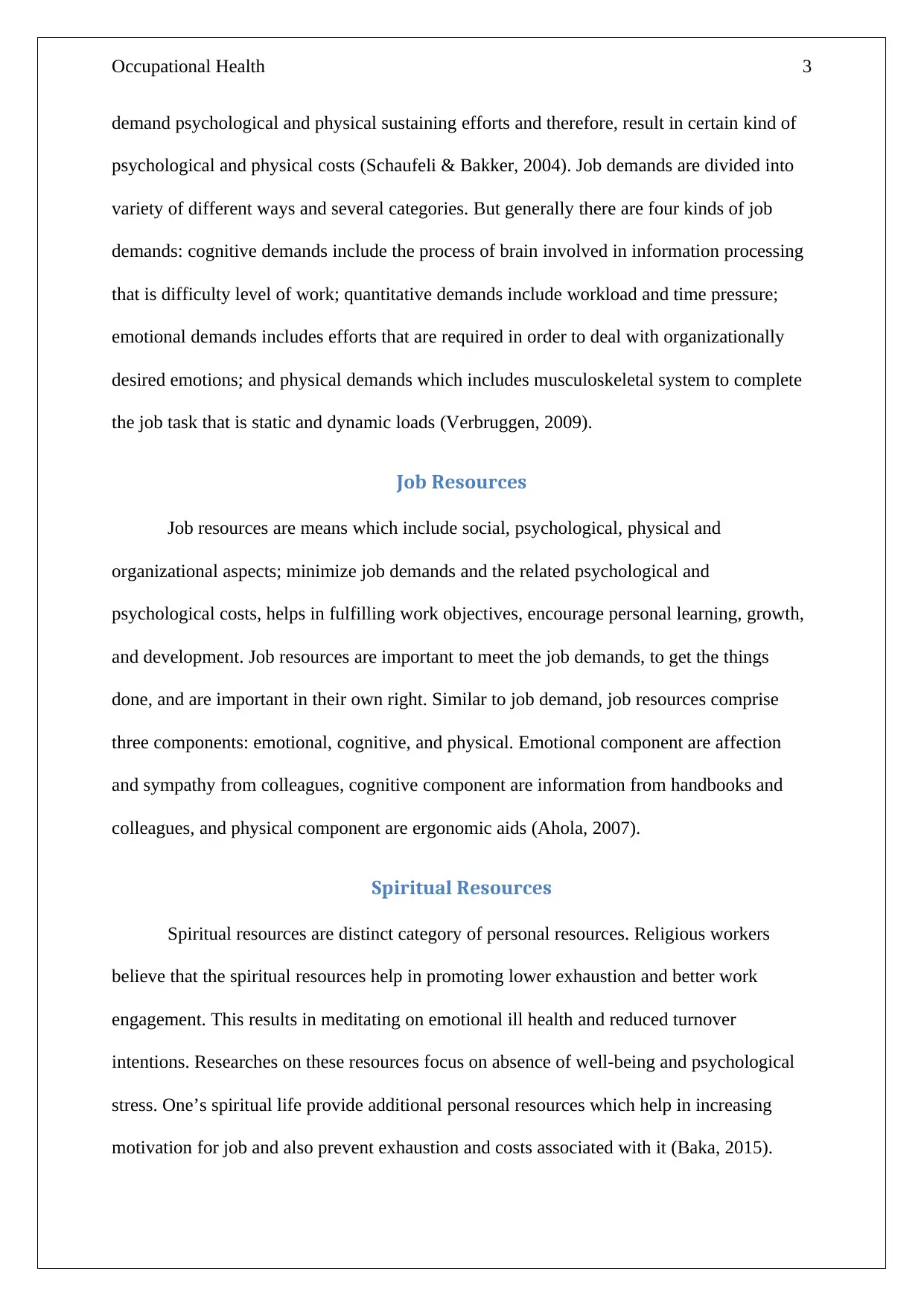
Occupational Health 3
demand psychological and physical sustaining efforts and therefore, result in certain kind of
psychological and physical costs (Schaufeli & Bakker, 2004). Job demands are divided into
variety of different ways and several categories. But generally there are four kinds of job
demands: cognitive demands include the process of brain involved in information processing
that is difficulty level of work; quantitative demands include workload and time pressure;
emotional demands includes efforts that are required in order to deal with organizationally
desired emotions; and physical demands which includes musculoskeletal system to complete
the job task that is static and dynamic loads (Verbruggen, 2009).
Job Resources
Job resources are means which include social, psychological, physical and
organizational aspects; minimize job demands and the related psychological and
psychological costs, helps in fulfilling work objectives, encourage personal learning, growth,
and development. Job resources are important to meet the job demands, to get the things
done, and are important in their own right. Similar to job demand, job resources comprise
three components: emotional, cognitive, and physical. Emotional component are affection
and sympathy from colleagues, cognitive component are information from handbooks and
colleagues, and physical component are ergonomic aids (Ahola, 2007).
Spiritual Resources
Spiritual resources are distinct category of personal resources. Religious workers
believe that the spiritual resources help in promoting lower exhaustion and better work
engagement. This results in meditating on emotional ill health and reduced turnover
intentions. Researches on these resources focus on absence of well-being and psychological
stress. One’s spiritual life provide additional personal resources which help in increasing
motivation for job and also prevent exhaustion and costs associated with it (Baka, 2015).
demand psychological and physical sustaining efforts and therefore, result in certain kind of
psychological and physical costs (Schaufeli & Bakker, 2004). Job demands are divided into
variety of different ways and several categories. But generally there are four kinds of job
demands: cognitive demands include the process of brain involved in information processing
that is difficulty level of work; quantitative demands include workload and time pressure;
emotional demands includes efforts that are required in order to deal with organizationally
desired emotions; and physical demands which includes musculoskeletal system to complete
the job task that is static and dynamic loads (Verbruggen, 2009).
Job Resources
Job resources are means which include social, psychological, physical and
organizational aspects; minimize job demands and the related psychological and
psychological costs, helps in fulfilling work objectives, encourage personal learning, growth,
and development. Job resources are important to meet the job demands, to get the things
done, and are important in their own right. Similar to job demand, job resources comprise
three components: emotional, cognitive, and physical. Emotional component are affection
and sympathy from colleagues, cognitive component are information from handbooks and
colleagues, and physical component are ergonomic aids (Ahola, 2007).
Spiritual Resources
Spiritual resources are distinct category of personal resources. Religious workers
believe that the spiritual resources help in promoting lower exhaustion and better work
engagement. This results in meditating on emotional ill health and reduced turnover
intentions. Researches on these resources focus on absence of well-being and psychological
stress. One’s spiritual life provide additional personal resources which help in increasing
motivation for job and also prevent exhaustion and costs associated with it (Baka, 2015).
Paraphrase This Document
Need a fresh take? Get an instant paraphrase of this document with our AI Paraphraser
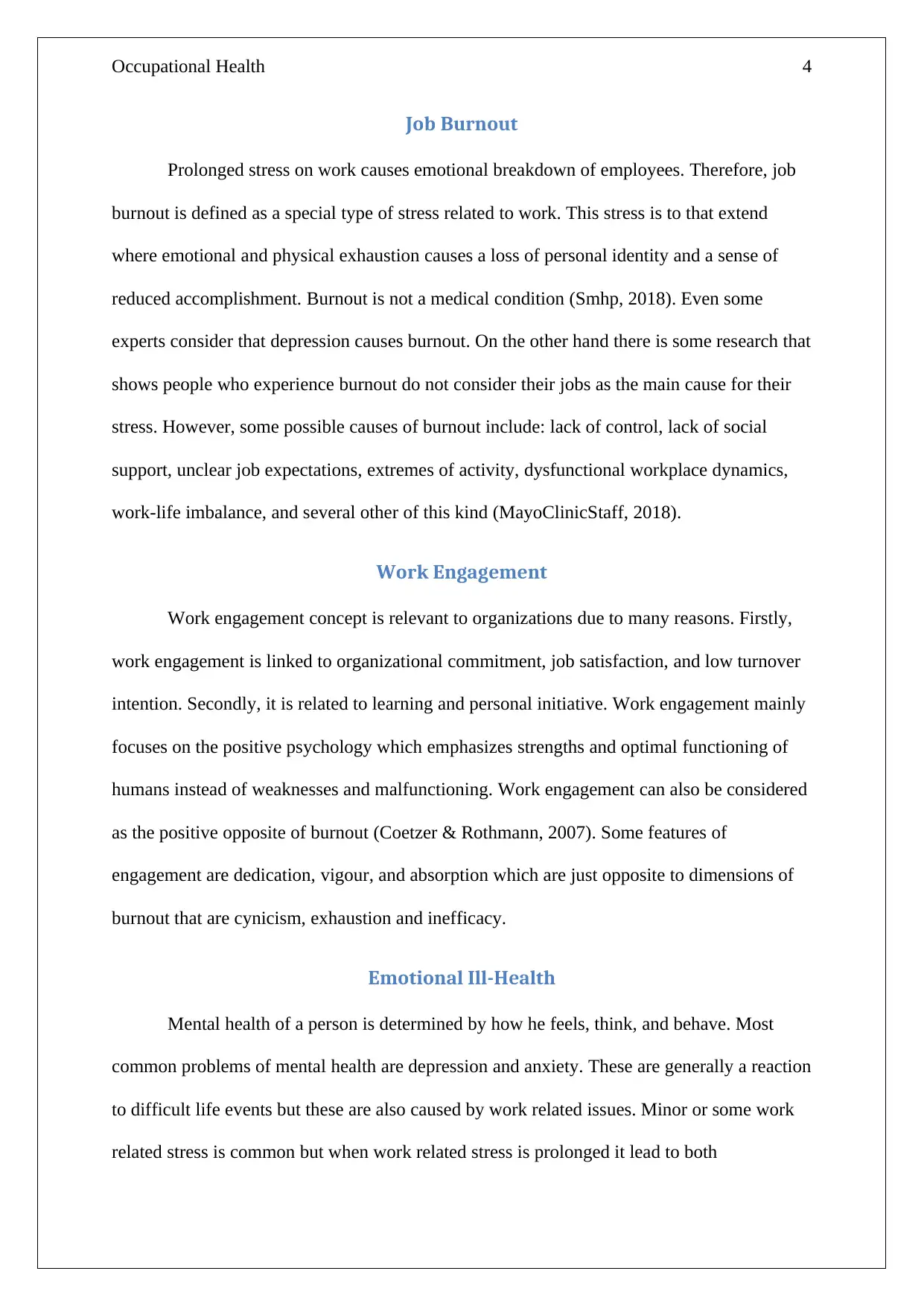
Occupational Health 4
Job Burnout
Prolonged stress on work causes emotional breakdown of employees. Therefore, job
burnout is defined as a special type of stress related to work. This stress is to that extend
where emotional and physical exhaustion causes a loss of personal identity and a sense of
reduced accomplishment. Burnout is not a medical condition (Smhp, 2018). Even some
experts consider that depression causes burnout. On the other hand there is some research that
shows people who experience burnout do not consider their jobs as the main cause for their
stress. However, some possible causes of burnout include: lack of control, lack of social
support, unclear job expectations, extremes of activity, dysfunctional workplace dynamics,
work-life imbalance, and several other of this kind (MayoClinicStaff, 2018).
Work Engagement
Work engagement concept is relevant to organizations due to many reasons. Firstly,
work engagement is linked to organizational commitment, job satisfaction, and low turnover
intention. Secondly, it is related to learning and personal initiative. Work engagement mainly
focuses on the positive psychology which emphasizes strengths and optimal functioning of
humans instead of weaknesses and malfunctioning. Work engagement can also be considered
as the positive opposite of burnout (Coetzer & Rothmann, 2007). Some features of
engagement are dedication, vigour, and absorption which are just opposite to dimensions of
burnout that are cynicism, exhaustion and inefficacy.
Emotional Ill-Health
Mental health of a person is determined by how he feels, think, and behave. Most
common problems of mental health are depression and anxiety. These are generally a reaction
to difficult life events but these are also caused by work related issues. Minor or some work
related stress is common but when work related stress is prolonged it lead to both
Job Burnout
Prolonged stress on work causes emotional breakdown of employees. Therefore, job
burnout is defined as a special type of stress related to work. This stress is to that extend
where emotional and physical exhaustion causes a loss of personal identity and a sense of
reduced accomplishment. Burnout is not a medical condition (Smhp, 2018). Even some
experts consider that depression causes burnout. On the other hand there is some research that
shows people who experience burnout do not consider their jobs as the main cause for their
stress. However, some possible causes of burnout include: lack of control, lack of social
support, unclear job expectations, extremes of activity, dysfunctional workplace dynamics,
work-life imbalance, and several other of this kind (MayoClinicStaff, 2018).
Work Engagement
Work engagement concept is relevant to organizations due to many reasons. Firstly,
work engagement is linked to organizational commitment, job satisfaction, and low turnover
intention. Secondly, it is related to learning and personal initiative. Work engagement mainly
focuses on the positive psychology which emphasizes strengths and optimal functioning of
humans instead of weaknesses and malfunctioning. Work engagement can also be considered
as the positive opposite of burnout (Coetzer & Rothmann, 2007). Some features of
engagement are dedication, vigour, and absorption which are just opposite to dimensions of
burnout that are cynicism, exhaustion and inefficacy.
Emotional Ill-Health
Mental health of a person is determined by how he feels, think, and behave. Most
common problems of mental health are depression and anxiety. These are generally a reaction
to difficult life events but these are also caused by work related issues. Minor or some work
related stress is common but when work related stress is prolonged it lead to both
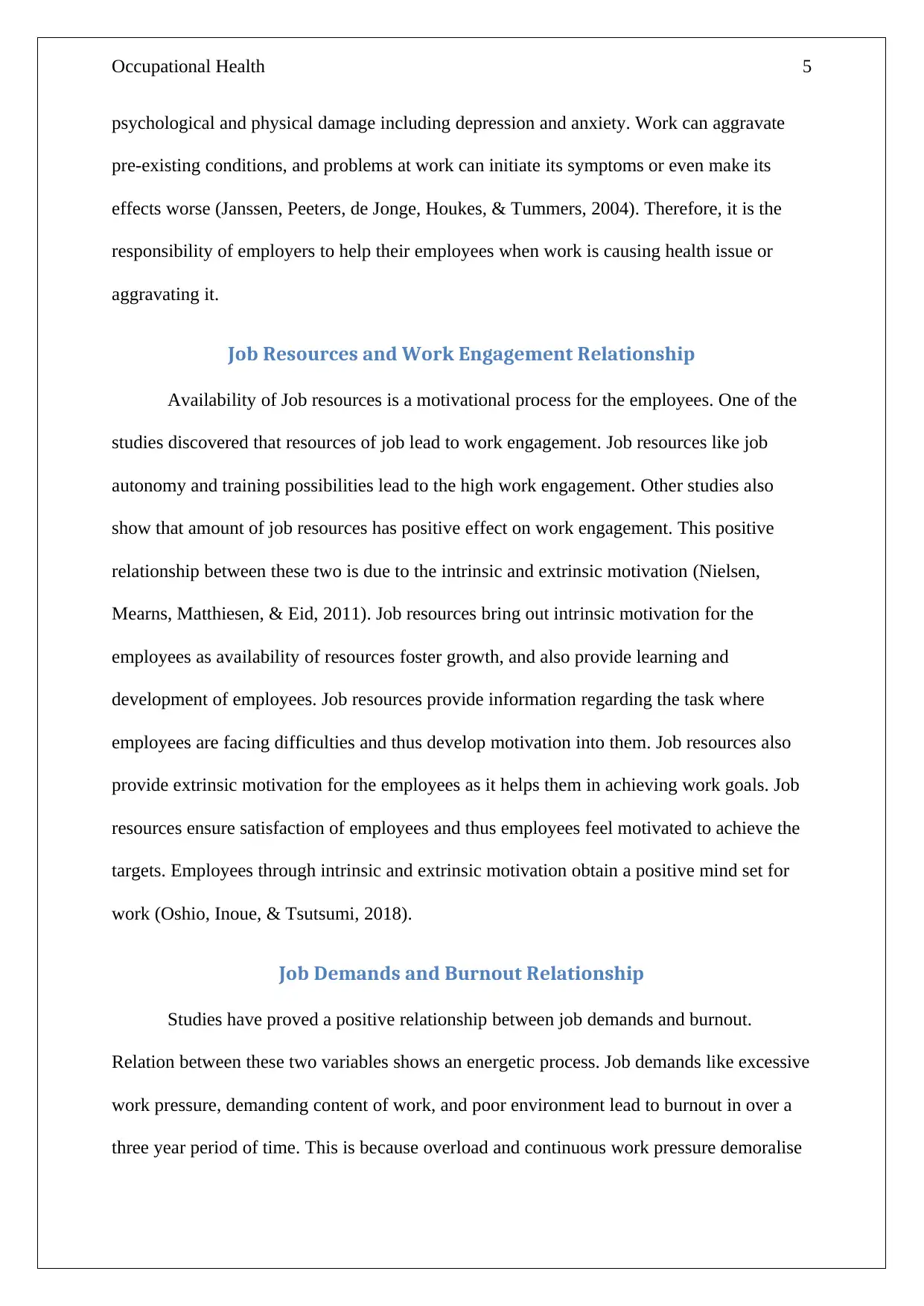
Occupational Health 5
psychological and physical damage including depression and anxiety. Work can aggravate
pre-existing conditions, and problems at work can initiate its symptoms or even make its
effects worse (Janssen, Peeters, de Jonge, Houkes, & Tummers, 2004). Therefore, it is the
responsibility of employers to help their employees when work is causing health issue or
aggravating it.
Job Resources and Work Engagement Relationship
Availability of Job resources is a motivational process for the employees. One of the
studies discovered that resources of job lead to work engagement. Job resources like job
autonomy and training possibilities lead to the high work engagement. Other studies also
show that amount of job resources has positive effect on work engagement. This positive
relationship between these two is due to the intrinsic and extrinsic motivation (Nielsen,
Mearns, Matthiesen, & Eid, 2011). Job resources bring out intrinsic motivation for the
employees as availability of resources foster growth, and also provide learning and
development of employees. Job resources provide information regarding the task where
employees are facing difficulties and thus develop motivation into them. Job resources also
provide extrinsic motivation for the employees as it helps them in achieving work goals. Job
resources ensure satisfaction of employees and thus employees feel motivated to achieve the
targets. Employees through intrinsic and extrinsic motivation obtain a positive mind set for
work (Oshio, Inoue, & Tsutsumi, 2018).
Job Demands and Burnout Relationship
Studies have proved a positive relationship between job demands and burnout.
Relation between these two variables shows an energetic process. Job demands like excessive
work pressure, demanding content of work, and poor environment lead to burnout in over a
three year period of time. This is because overload and continuous work pressure demoralise
psychological and physical damage including depression and anxiety. Work can aggravate
pre-existing conditions, and problems at work can initiate its symptoms or even make its
effects worse (Janssen, Peeters, de Jonge, Houkes, & Tummers, 2004). Therefore, it is the
responsibility of employers to help their employees when work is causing health issue or
aggravating it.
Job Resources and Work Engagement Relationship
Availability of Job resources is a motivational process for the employees. One of the
studies discovered that resources of job lead to work engagement. Job resources like job
autonomy and training possibilities lead to the high work engagement. Other studies also
show that amount of job resources has positive effect on work engagement. This positive
relationship between these two is due to the intrinsic and extrinsic motivation (Nielsen,
Mearns, Matthiesen, & Eid, 2011). Job resources bring out intrinsic motivation for the
employees as availability of resources foster growth, and also provide learning and
development of employees. Job resources provide information regarding the task where
employees are facing difficulties and thus develop motivation into them. Job resources also
provide extrinsic motivation for the employees as it helps them in achieving work goals. Job
resources ensure satisfaction of employees and thus employees feel motivated to achieve the
targets. Employees through intrinsic and extrinsic motivation obtain a positive mind set for
work (Oshio, Inoue, & Tsutsumi, 2018).
Job Demands and Burnout Relationship
Studies have proved a positive relationship between job demands and burnout.
Relation between these two variables shows an energetic process. Job demands like excessive
work pressure, demanding content of work, and poor environment lead to burnout in over a
three year period of time. This is because overload and continuous work pressure demoralise
⊘ This is a preview!⊘
Do you want full access?
Subscribe today to unlock all pages.

Trusted by 1+ million students worldwide
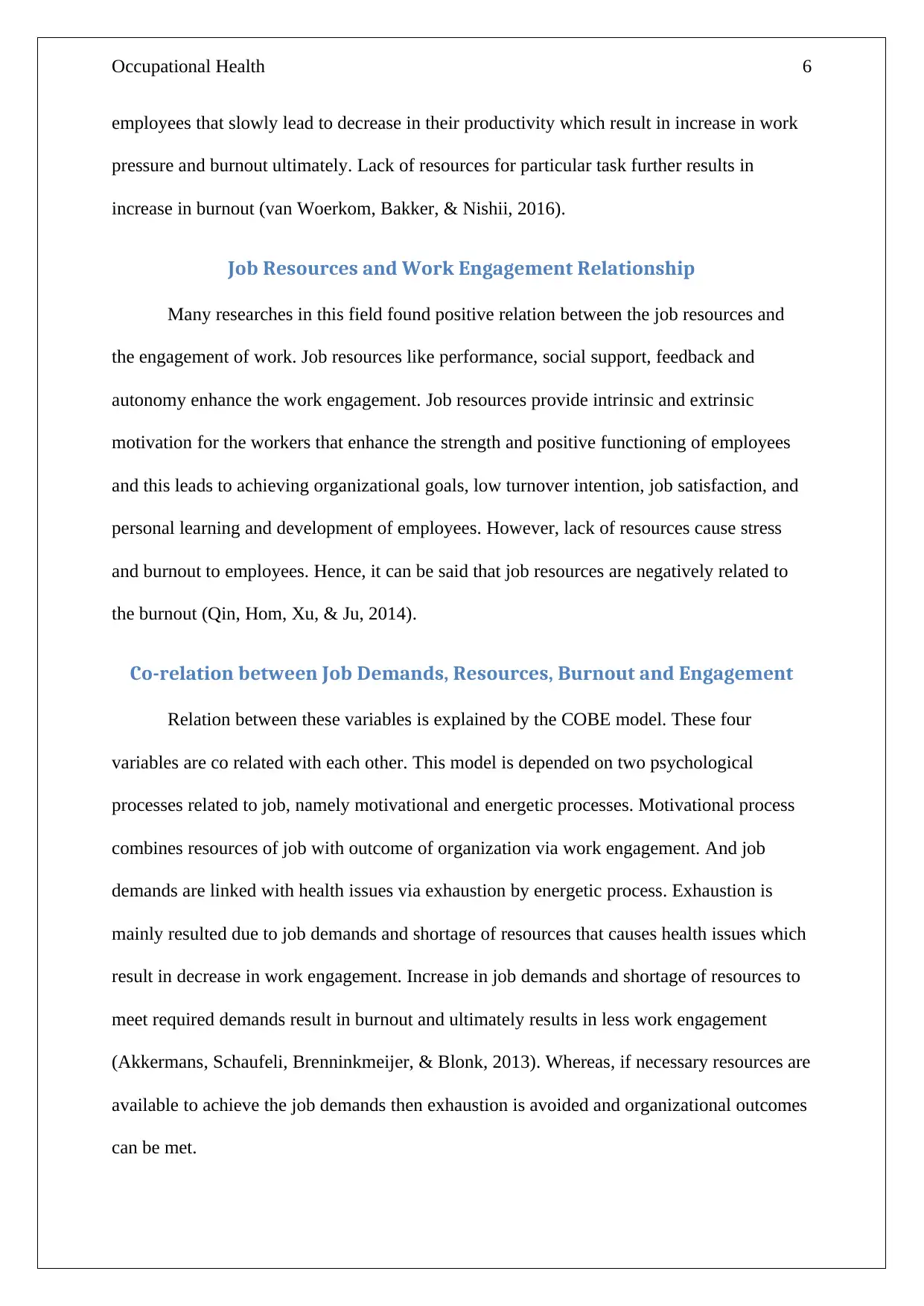
Occupational Health 6
employees that slowly lead to decrease in their productivity which result in increase in work
pressure and burnout ultimately. Lack of resources for particular task further results in
increase in burnout (van Woerkom, Bakker, & Nishii, 2016).
Job Resources and Work Engagement Relationship
Many researches in this field found positive relation between the job resources and
the engagement of work. Job resources like performance, social support, feedback and
autonomy enhance the work engagement. Job resources provide intrinsic and extrinsic
motivation for the workers that enhance the strength and positive functioning of employees
and this leads to achieving organizational goals, low turnover intention, job satisfaction, and
personal learning and development of employees. However, lack of resources cause stress
and burnout to employees. Hence, it can be said that job resources are negatively related to
the burnout (Qin, Hom, Xu, & Ju, 2014).
Co-relation between Job Demands, Resources, Burnout and Engagement
Relation between these variables is explained by the COBE model. These four
variables are co related with each other. This model is depended on two psychological
processes related to job, namely motivational and energetic processes. Motivational process
combines resources of job with outcome of organization via work engagement. And job
demands are linked with health issues via exhaustion by energetic process. Exhaustion is
mainly resulted due to job demands and shortage of resources that causes health issues which
result in decrease in work engagement. Increase in job demands and shortage of resources to
meet required demands result in burnout and ultimately results in less work engagement
(Akkermans, Schaufeli, Brenninkmeijer, & Blonk, 2013). Whereas, if necessary resources are
available to achieve the job demands then exhaustion is avoided and organizational outcomes
can be met.
employees that slowly lead to decrease in their productivity which result in increase in work
pressure and burnout ultimately. Lack of resources for particular task further results in
increase in burnout (van Woerkom, Bakker, & Nishii, 2016).
Job Resources and Work Engagement Relationship
Many researches in this field found positive relation between the job resources and
the engagement of work. Job resources like performance, social support, feedback and
autonomy enhance the work engagement. Job resources provide intrinsic and extrinsic
motivation for the workers that enhance the strength and positive functioning of employees
and this leads to achieving organizational goals, low turnover intention, job satisfaction, and
personal learning and development of employees. However, lack of resources cause stress
and burnout to employees. Hence, it can be said that job resources are negatively related to
the burnout (Qin, Hom, Xu, & Ju, 2014).
Co-relation between Job Demands, Resources, Burnout and Engagement
Relation between these variables is explained by the COBE model. These four
variables are co related with each other. This model is depended on two psychological
processes related to job, namely motivational and energetic processes. Motivational process
combines resources of job with outcome of organization via work engagement. And job
demands are linked with health issues via exhaustion by energetic process. Exhaustion is
mainly resulted due to job demands and shortage of resources that causes health issues which
result in decrease in work engagement. Increase in job demands and shortage of resources to
meet required demands result in burnout and ultimately results in less work engagement
(Akkermans, Schaufeli, Brenninkmeijer, & Blonk, 2013). Whereas, if necessary resources are
available to achieve the job demands then exhaustion is avoided and organizational outcomes
can be met.
Paraphrase This Document
Need a fresh take? Get an instant paraphrase of this document with our AI Paraphraser
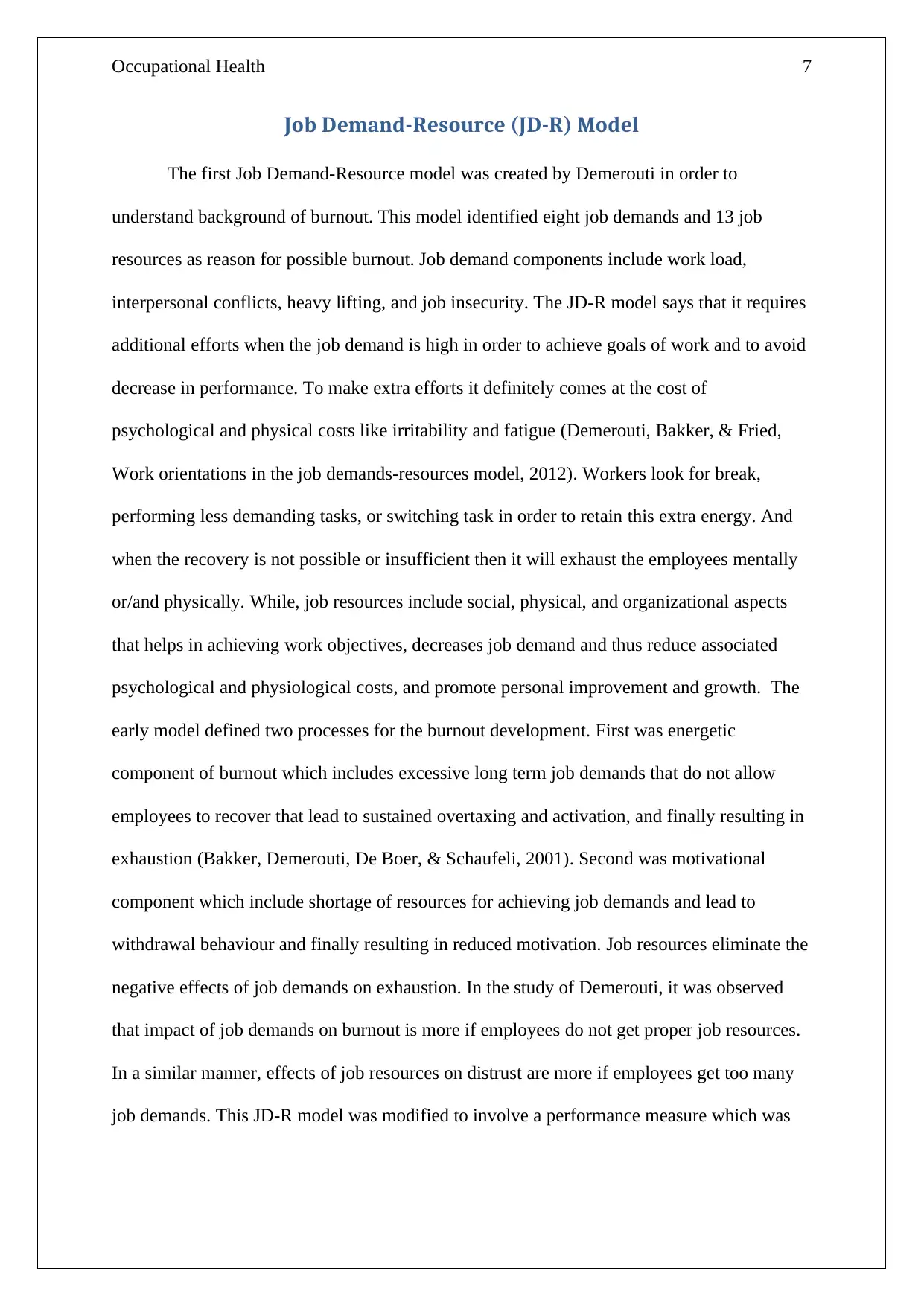
Occupational Health 7
Job Demand-Resource (JD-R) Model
The first Job Demand-Resource model was created by Demerouti in order to
understand background of burnout. This model identified eight job demands and 13 job
resources as reason for possible burnout. Job demand components include work load,
interpersonal conflicts, heavy lifting, and job insecurity. The JD-R model says that it requires
additional efforts when the job demand is high in order to achieve goals of work and to avoid
decrease in performance. To make extra efforts it definitely comes at the cost of
psychological and physical costs like irritability and fatigue (Demerouti, Bakker, & Fried,
Work orientations in the job demands-resources model, 2012). Workers look for break,
performing less demanding tasks, or switching task in order to retain this extra energy. And
when the recovery is not possible or insufficient then it will exhaust the employees mentally
or/and physically. While, job resources include social, physical, and organizational aspects
that helps in achieving work objectives, decreases job demand and thus reduce associated
psychological and physiological costs, and promote personal improvement and growth. The
early model defined two processes for the burnout development. First was energetic
component of burnout which includes excessive long term job demands that do not allow
employees to recover that lead to sustained overtaxing and activation, and finally resulting in
exhaustion (Bakker, Demerouti, De Boer, & Schaufeli, 2001). Second was motivational
component which include shortage of resources for achieving job demands and lead to
withdrawal behaviour and finally resulting in reduced motivation. Job resources eliminate the
negative effects of job demands on exhaustion. In the study of Demerouti, it was observed
that impact of job demands on burnout is more if employees do not get proper job resources.
In a similar manner, effects of job resources on distrust are more if employees get too many
job demands. This JD-R model was modified to involve a performance measure which was
Job Demand-Resource (JD-R) Model
The first Job Demand-Resource model was created by Demerouti in order to
understand background of burnout. This model identified eight job demands and 13 job
resources as reason for possible burnout. Job demand components include work load,
interpersonal conflicts, heavy lifting, and job insecurity. The JD-R model says that it requires
additional efforts when the job demand is high in order to achieve goals of work and to avoid
decrease in performance. To make extra efforts it definitely comes at the cost of
psychological and physical costs like irritability and fatigue (Demerouti, Bakker, & Fried,
Work orientations in the job demands-resources model, 2012). Workers look for break,
performing less demanding tasks, or switching task in order to retain this extra energy. And
when the recovery is not possible or insufficient then it will exhaust the employees mentally
or/and physically. While, job resources include social, physical, and organizational aspects
that helps in achieving work objectives, decreases job demand and thus reduce associated
psychological and physiological costs, and promote personal improvement and growth. The
early model defined two processes for the burnout development. First was energetic
component of burnout which includes excessive long term job demands that do not allow
employees to recover that lead to sustained overtaxing and activation, and finally resulting in
exhaustion (Bakker, Demerouti, De Boer, & Schaufeli, 2001). Second was motivational
component which include shortage of resources for achieving job demands and lead to
withdrawal behaviour and finally resulting in reduced motivation. Job resources eliminate the
negative effects of job demands on exhaustion. In the study of Demerouti, it was observed
that impact of job demands on burnout is more if employees do not get proper job resources.
In a similar manner, effects of job resources on distrust are more if employees get too many
job demands. This JD-R model was modified to involve a performance measure which was
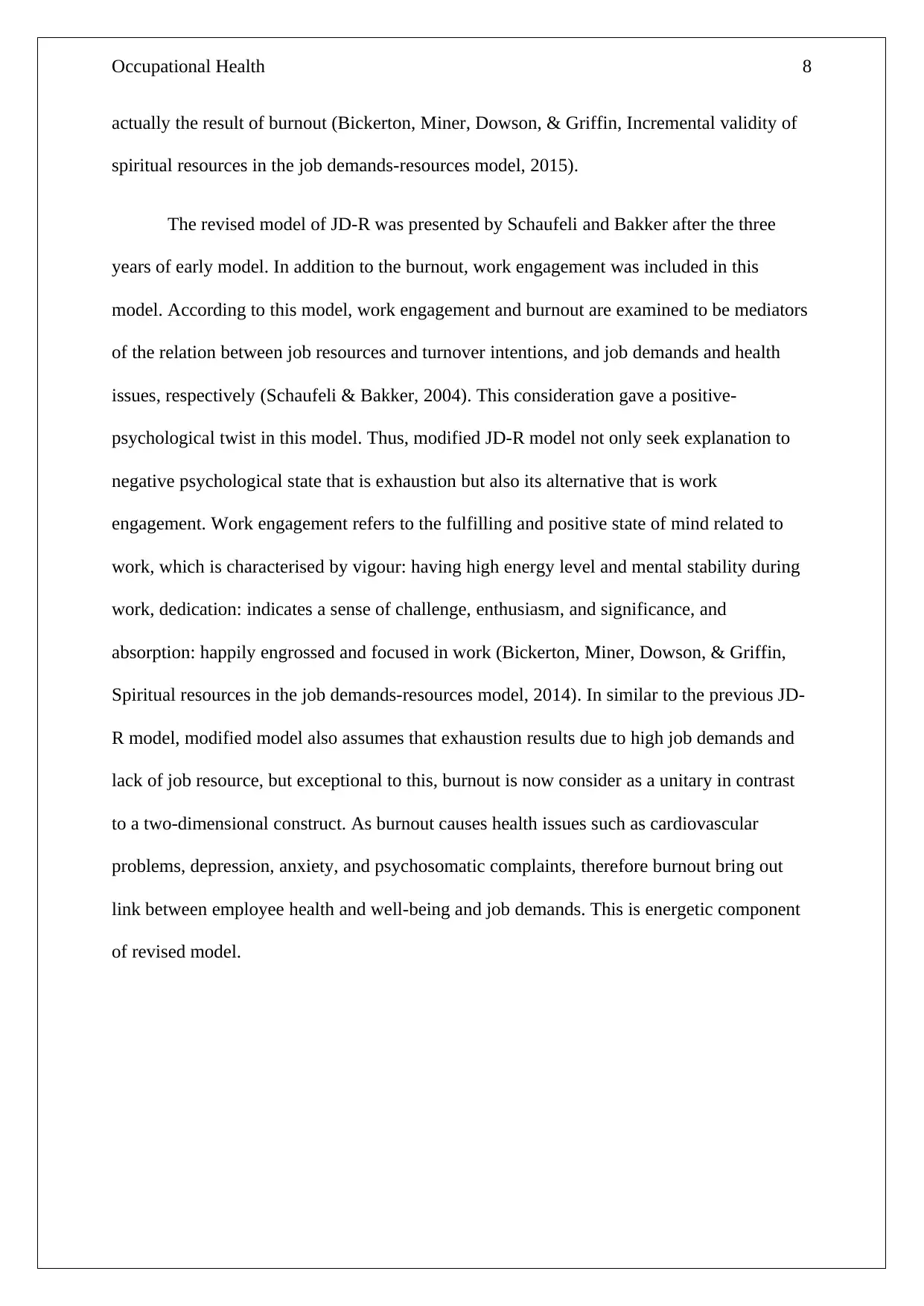
Occupational Health 8
actually the result of burnout (Bickerton, Miner, Dowson, & Griffin, Incremental validity of
spiritual resources in the job demands-resources model, 2015).
The revised model of JD-R was presented by Schaufeli and Bakker after the three
years of early model. In addition to the burnout, work engagement was included in this
model. According to this model, work engagement and burnout are examined to be mediators
of the relation between job resources and turnover intentions, and job demands and health
issues, respectively (Schaufeli & Bakker, 2004). This consideration gave a positive-
psychological twist in this model. Thus, modified JD-R model not only seek explanation to
negative psychological state that is exhaustion but also its alternative that is work
engagement. Work engagement refers to the fulfilling and positive state of mind related to
work, which is characterised by vigour: having high energy level and mental stability during
work, dedication: indicates a sense of challenge, enthusiasm, and significance, and
absorption: happily engrossed and focused in work (Bickerton, Miner, Dowson, & Griffin,
Spiritual resources in the job demands-resources model, 2014). In similar to the previous JD-
R model, modified model also assumes that exhaustion results due to high job demands and
lack of job resource, but exceptional to this, burnout is now consider as a unitary in contrast
to a two-dimensional construct. As burnout causes health issues such as cardiovascular
problems, depression, anxiety, and psychosomatic complaints, therefore burnout bring out
link between employee health and well-being and job demands. This is energetic component
of revised model.
actually the result of burnout (Bickerton, Miner, Dowson, & Griffin, Incremental validity of
spiritual resources in the job demands-resources model, 2015).
The revised model of JD-R was presented by Schaufeli and Bakker after the three
years of early model. In addition to the burnout, work engagement was included in this
model. According to this model, work engagement and burnout are examined to be mediators
of the relation between job resources and turnover intentions, and job demands and health
issues, respectively (Schaufeli & Bakker, 2004). This consideration gave a positive-
psychological twist in this model. Thus, modified JD-R model not only seek explanation to
negative psychological state that is exhaustion but also its alternative that is work
engagement. Work engagement refers to the fulfilling and positive state of mind related to
work, which is characterised by vigour: having high energy level and mental stability during
work, dedication: indicates a sense of challenge, enthusiasm, and significance, and
absorption: happily engrossed and focused in work (Bickerton, Miner, Dowson, & Griffin,
Spiritual resources in the job demands-resources model, 2014). In similar to the previous JD-
R model, modified model also assumes that exhaustion results due to high job demands and
lack of job resource, but exceptional to this, burnout is now consider as a unitary in contrast
to a two-dimensional construct. As burnout causes health issues such as cardiovascular
problems, depression, anxiety, and psychosomatic complaints, therefore burnout bring out
link between employee health and well-being and job demands. This is energetic component
of revised model.
⊘ This is a preview!⊘
Do you want full access?
Subscribe today to unlock all pages.

Trusted by 1+ million students worldwide
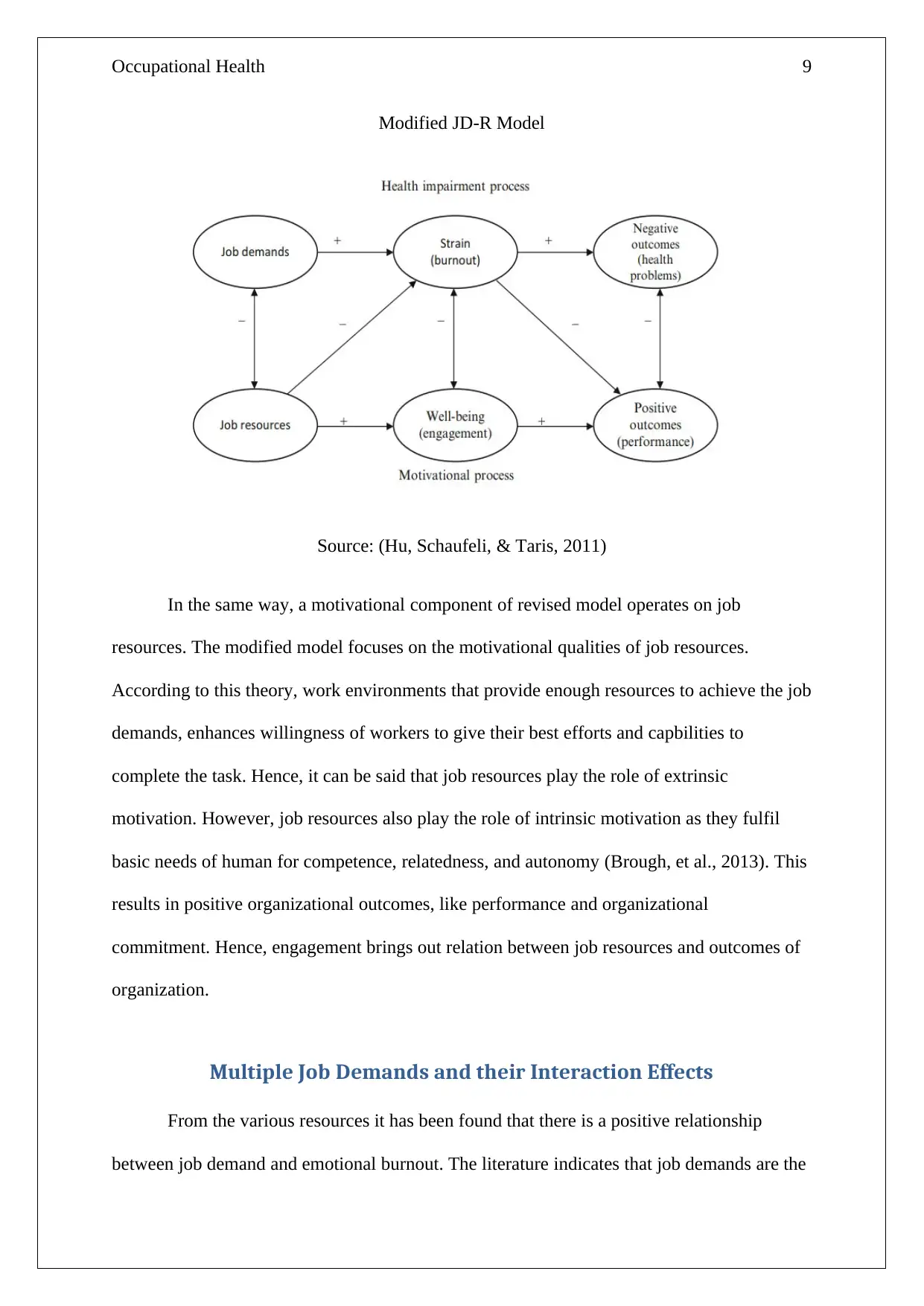
Occupational Health 9
Modified JD-R Model
Source: (Hu, Schaufeli, & Taris, 2011)
In the same way, a motivational component of revised model operates on job
resources. The modified model focuses on the motivational qualities of job resources.
According to this theory, work environments that provide enough resources to achieve the job
demands, enhances willingness of workers to give their best efforts and capbilities to
complete the task. Hence, it can be said that job resources play the role of extrinsic
motivation. However, job resources also play the role of intrinsic motivation as they fulfil
basic needs of human for competence, relatedness, and autonomy (Brough, et al., 2013). This
results in positive organizational outcomes, like performance and organizational
commitment. Hence, engagement brings out relation between job resources and outcomes of
organization.
Multiple Job Demands and their Interaction Effects
From the various resources it has been found that there is a positive relationship
between job demand and emotional burnout. The literature indicates that job demands are the
Modified JD-R Model
Source: (Hu, Schaufeli, & Taris, 2011)
In the same way, a motivational component of revised model operates on job
resources. The modified model focuses on the motivational qualities of job resources.
According to this theory, work environments that provide enough resources to achieve the job
demands, enhances willingness of workers to give their best efforts and capbilities to
complete the task. Hence, it can be said that job resources play the role of extrinsic
motivation. However, job resources also play the role of intrinsic motivation as they fulfil
basic needs of human for competence, relatedness, and autonomy (Brough, et al., 2013). This
results in positive organizational outcomes, like performance and organizational
commitment. Hence, engagement brings out relation between job resources and outcomes of
organization.
Multiple Job Demands and their Interaction Effects
From the various resources it has been found that there is a positive relationship
between job demand and emotional burnout. The literature indicates that job demands are the
Paraphrase This Document
Need a fresh take? Get an instant paraphrase of this document with our AI Paraphraser
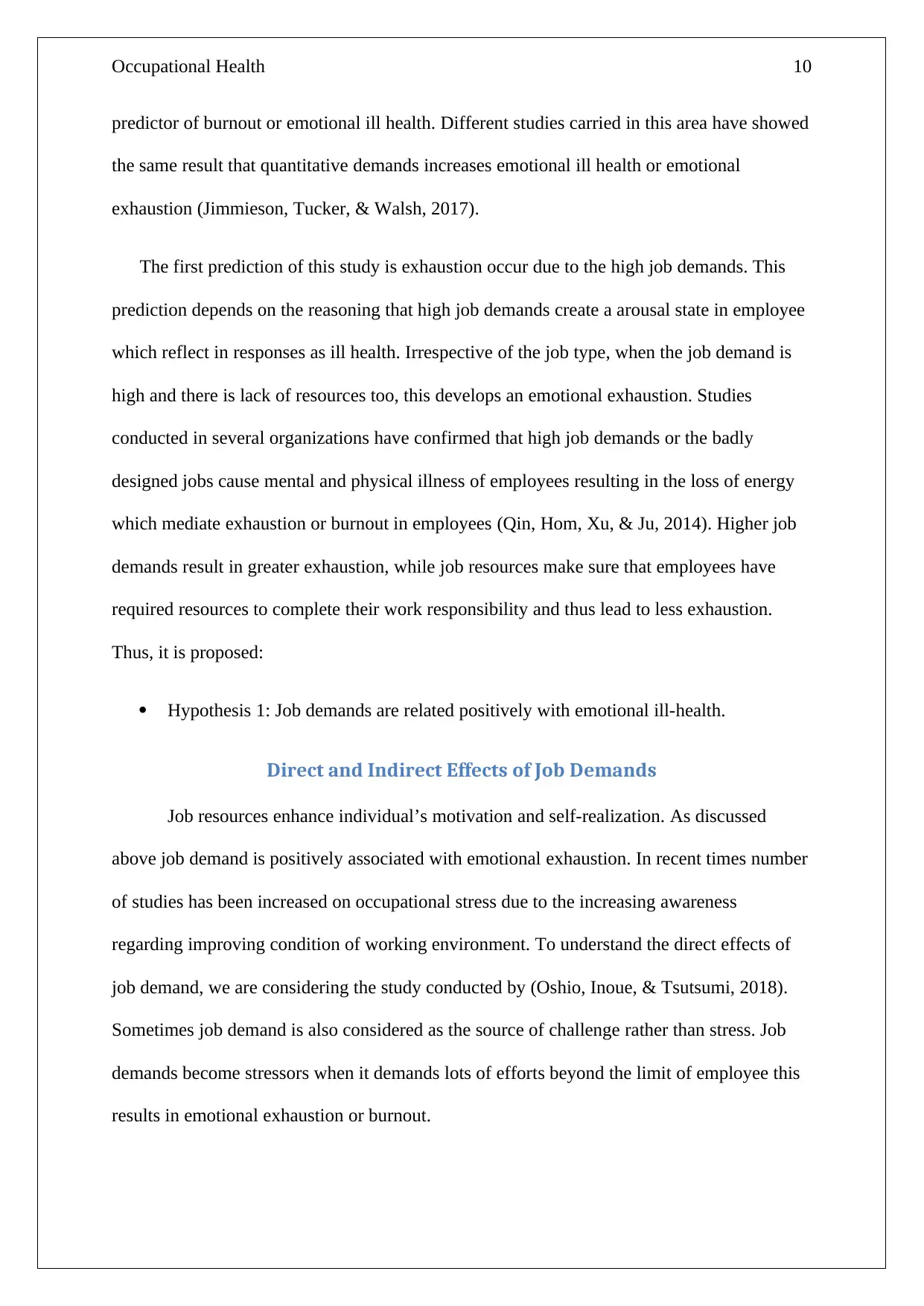
Occupational Health 10
predictor of burnout or emotional ill health. Different studies carried in this area have showed
the same result that quantitative demands increases emotional ill health or emotional
exhaustion (Jimmieson, Tucker, & Walsh, 2017).
The first prediction of this study is exhaustion occur due to the high job demands. This
prediction depends on the reasoning that high job demands create a arousal state in employee
which reflect in responses as ill health. Irrespective of the job type, when the job demand is
high and there is lack of resources too, this develops an emotional exhaustion. Studies
conducted in several organizations have confirmed that high job demands or the badly
designed jobs cause mental and physical illness of employees resulting in the loss of energy
which mediate exhaustion or burnout in employees (Qin, Hom, Xu, & Ju, 2014). Higher job
demands result in greater exhaustion, while job resources make sure that employees have
required resources to complete their work responsibility and thus lead to less exhaustion.
Thus, it is proposed:
Hypothesis 1: Job demands are related positively with emotional ill-health.
Direct and Indirect Effects of Job Demands
Job resources enhance individual’s motivation and self-realization. As discussed
above job demand is positively associated with emotional exhaustion. In recent times number
of studies has been increased on occupational stress due to the increasing awareness
regarding improving condition of working environment. To understand the direct effects of
job demand, we are considering the study conducted by (Oshio, Inoue, & Tsutsumi, 2018).
Sometimes job demand is also considered as the source of challenge rather than stress. Job
demands become stressors when it demands lots of efforts beyond the limit of employee this
results in emotional exhaustion or burnout.
predictor of burnout or emotional ill health. Different studies carried in this area have showed
the same result that quantitative demands increases emotional ill health or emotional
exhaustion (Jimmieson, Tucker, & Walsh, 2017).
The first prediction of this study is exhaustion occur due to the high job demands. This
prediction depends on the reasoning that high job demands create a arousal state in employee
which reflect in responses as ill health. Irrespective of the job type, when the job demand is
high and there is lack of resources too, this develops an emotional exhaustion. Studies
conducted in several organizations have confirmed that high job demands or the badly
designed jobs cause mental and physical illness of employees resulting in the loss of energy
which mediate exhaustion or burnout in employees (Qin, Hom, Xu, & Ju, 2014). Higher job
demands result in greater exhaustion, while job resources make sure that employees have
required resources to complete their work responsibility and thus lead to less exhaustion.
Thus, it is proposed:
Hypothesis 1: Job demands are related positively with emotional ill-health.
Direct and Indirect Effects of Job Demands
Job resources enhance individual’s motivation and self-realization. As discussed
above job demand is positively associated with emotional exhaustion. In recent times number
of studies has been increased on occupational stress due to the increasing awareness
regarding improving condition of working environment. To understand the direct effects of
job demand, we are considering the study conducted by (Oshio, Inoue, & Tsutsumi, 2018).
Sometimes job demand is also considered as the source of challenge rather than stress. Job
demands become stressors when it demands lots of efforts beyond the limit of employee this
results in emotional exhaustion or burnout.
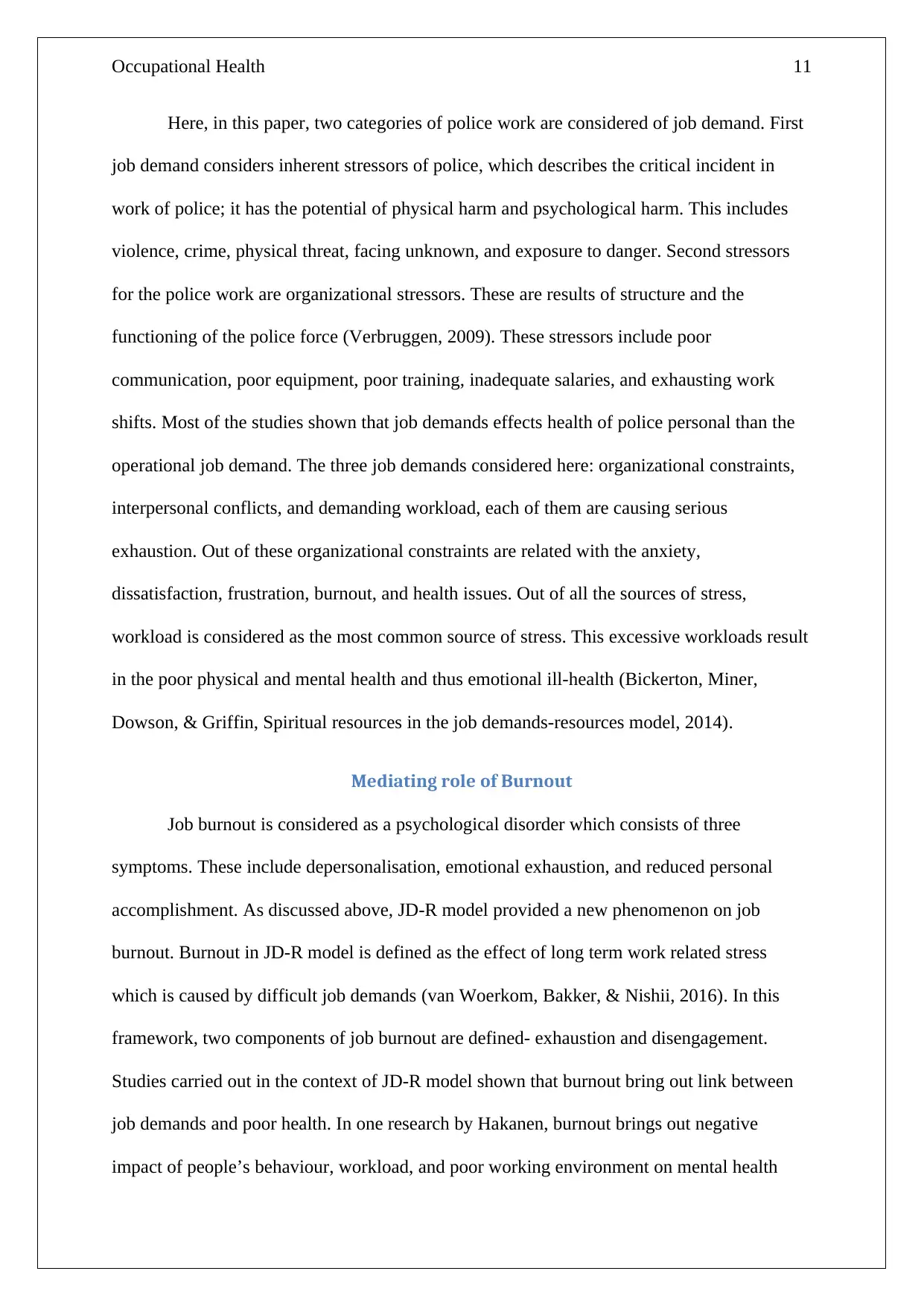
Occupational Health 11
Here, in this paper, two categories of police work are considered of job demand. First
job demand considers inherent stressors of police, which describes the critical incident in
work of police; it has the potential of physical harm and psychological harm. This includes
violence, crime, physical threat, facing unknown, and exposure to danger. Second stressors
for the police work are organizational stressors. These are results of structure and the
functioning of the police force (Verbruggen, 2009). These stressors include poor
communication, poor equipment, poor training, inadequate salaries, and exhausting work
shifts. Most of the studies shown that job demands effects health of police personal than the
operational job demand. The three job demands considered here: organizational constraints,
interpersonal conflicts, and demanding workload, each of them are causing serious
exhaustion. Out of these organizational constraints are related with the anxiety,
dissatisfaction, frustration, burnout, and health issues. Out of all the sources of stress,
workload is considered as the most common source of stress. This excessive workloads result
in the poor physical and mental health and thus emotional ill-health (Bickerton, Miner,
Dowson, & Griffin, Spiritual resources in the job demands-resources model, 2014).
Mediating role of Burnout
Job burnout is considered as a psychological disorder which consists of three
symptoms. These include depersonalisation, emotional exhaustion, and reduced personal
accomplishment. As discussed above, JD-R model provided a new phenomenon on job
burnout. Burnout in JD-R model is defined as the effect of long term work related stress
which is caused by difficult job demands (van Woerkom, Bakker, & Nishii, 2016). In this
framework, two components of job burnout are defined- exhaustion and disengagement.
Studies carried out in the context of JD-R model shown that burnout bring out link between
job demands and poor health. In one research by Hakanen, burnout brings out negative
impact of people’s behaviour, workload, and poor working environment on mental health
Here, in this paper, two categories of police work are considered of job demand. First
job demand considers inherent stressors of police, which describes the critical incident in
work of police; it has the potential of physical harm and psychological harm. This includes
violence, crime, physical threat, facing unknown, and exposure to danger. Second stressors
for the police work are organizational stressors. These are results of structure and the
functioning of the police force (Verbruggen, 2009). These stressors include poor
communication, poor equipment, poor training, inadequate salaries, and exhausting work
shifts. Most of the studies shown that job demands effects health of police personal than the
operational job demand. The three job demands considered here: organizational constraints,
interpersonal conflicts, and demanding workload, each of them are causing serious
exhaustion. Out of these organizational constraints are related with the anxiety,
dissatisfaction, frustration, burnout, and health issues. Out of all the sources of stress,
workload is considered as the most common source of stress. This excessive workloads result
in the poor physical and mental health and thus emotional ill-health (Bickerton, Miner,
Dowson, & Griffin, Spiritual resources in the job demands-resources model, 2014).
Mediating role of Burnout
Job burnout is considered as a psychological disorder which consists of three
symptoms. These include depersonalisation, emotional exhaustion, and reduced personal
accomplishment. As discussed above, JD-R model provided a new phenomenon on job
burnout. Burnout in JD-R model is defined as the effect of long term work related stress
which is caused by difficult job demands (van Woerkom, Bakker, & Nishii, 2016). In this
framework, two components of job burnout are defined- exhaustion and disengagement.
Studies carried out in the context of JD-R model shown that burnout bring out link between
job demands and poor health. In one research by Hakanen, burnout brings out negative
impact of people’s behaviour, workload, and poor working environment on mental health
⊘ This is a preview!⊘
Do you want full access?
Subscribe today to unlock all pages.

Trusted by 1+ million students worldwide
1 out of 17
Related Documents
Your All-in-One AI-Powered Toolkit for Academic Success.
+13062052269
info@desklib.com
Available 24*7 on WhatsApp / Email
![[object Object]](/_next/static/media/star-bottom.7253800d.svg)
Unlock your academic potential
Copyright © 2020–2025 A2Z Services. All Rights Reserved. Developed and managed by ZUCOL.





